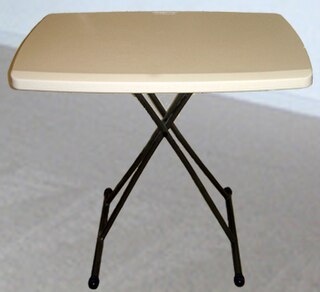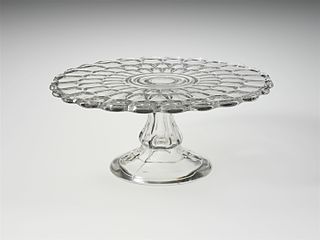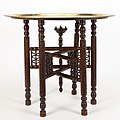
A hinge is a mechanical bearing that connects two solid objects, typically allowing only a limited angle of rotation between them. Two objects connected by an ideal hinge rotate relative to each other about a fixed axis of rotation, with all other translations or rotations prevented; thus a hinge has one degree of freedom. Hinges may be made of flexible material or moving components. In biology, many joints function as hinges, such as the elbow joint.

A tray is a shallow platform designed for the carrying of items. It can be fashioned from numerous materials, including silver, brass, sheet iron, paperboard, wood, melamine, and molded pulp. Trays range in cost from inexpensive molded pulp trays which are disposable and inexpensive melamine trays used in cafeterias, to mid-priced wooden trays used in a home, to expensive silver trays used in luxury hotels. Some examples have raised galleries, handles, and short feet for support.

Optical disc packaging is the packaging that accompanies CDs, DVDs, and other formats of optical discs. Most packaging is rigid or semi-rigid and designed to protect the media from scratches and other types of exposure damage.

Tabletop games or tabletops are games that are normally played on a table or other flat surface, such as board games, card games, dice games, miniature wargames, or tile-based games.

A table is an item of furniture with a raised flat top and is supported most commonly by 1 to 4 legs. It is used as a surface for working at, eating from or on which to place things. Some common types of tables are the dining room tables, which are used for seated persons to eat meals; the coffee table, which is a low table used in living rooms to display items or serve refreshments; and the bedside table, which is commonly used to place an alarm clock and a lamp. There are also a range of specialized types of tables, such as drafting tables, used for doing architectural drawings, and sewing tables.

A bipod is a V-shaped portable attachment that helps support and steady a device, usually a weapon such as a long gun or a mortar. The term comes from the Latin prefix bi- and Greek root pod, meaning "two" and "foot" respectively.

In duplicate bridge, a board is an item of equipment that holds one deal, or one deck of 52 cards distributed in four hands of 13 cards each. The design permits the entire deal of four hands to be passed, carried or stacked securely with the cards hidden from view in four pockets. This is required for in-person duplicate bridge tournaments, where the same deal is played several times and so the composition of each hand must be preserved during and after each play of each deal. When bridge is played online, the functions of the physical boards are replaced by the software.

A clamshell design is a kind of form factor for electronic devices in the shape of a clamshell. Mobile phones, handheld game consoles, and especially laptops, are often designed like clamshells. Clamshell devices are usually made of two sections connected by a hinge, each section containing either a flat panel display or an alphanumeric keyboard/keypad, which can fold into contact together like a bivalve shell.

A tonneau, bed or tray is an area of a car or truck open at the top. It can be for passengers or cargo.

The trunk or boot of a car is the vehicle's main storage or cargo compartment, often a hatch at the rear of the vehicle. It can also be called a tailgate.

A toolbox is a box to organize, carry, and protect the owner's tools. They could be used for trade, a hobby or DIY, and their contents vary with the craft.

A TV tray table, TV dinner tray, TV table, or personal table is a type of collapsible furniture that functions as a small and easily portable, folding table. These small tables were originally designed to be a surface from which one could eat a meal while watching television. The phrase tray-table can also refer to a fold-away tray, such as those found in front of airline seats.

A picnic table is a table with benches, designed for working with and for outdoor dining. The term is often specifically associated with rectangular tables having an A-frame structure. Such tables may be referred to as "picnic tables" even when used exclusively indoors.

A poker table or card table is a table specifically designed for playing card games.

A gateleg table is a type of furniture first introduced in England in the 16th century. The table top has a fixed section and one or two hinged leaves, which, when not in use, fold down below the fixed section to hang vertically.

A drop-leaf table is a table that has a fixed section in the center and a hinged section (leaf) on either side that can be folded down (dropped). If the leaf is supported by a bracket when folded up, the table is simply a drop-leaf table; if the leaf is supported by legs that swing out from the center, it is known as a gateleg table. Depending on the style of drop-leaf or gateleg tables, the leaves vary from coming almost down to the floor to only coming down slightly.

Ironing is the use of an iron, usually heated, to remove wrinkles and unwanted creases from fabric. The heating is commonly done to a temperature of 180–220 °Celsius, depending on the fabric. Ironing works by loosening the bonds between the long-chain polymer molecules in the fibres of the material. While the molecules are hot, the fibres are straightened by the weight of the iron, and they hold their new shape as they cool. Some fabrics, such as cotton, require the addition of water to loosen the intermolecular bonds. Many modern fabrics are advertised as needing little or no ironing. Permanent press clothing was developed to reduce the ironing necessary by combining wrinkle-resistant polyester with cotton.

A Tip-top table is a folding table with the tabletop hinged so it can be placed into a vertical position when not used to save space. It is also called tilt-top table, tip table, snap table some variations are known as tea table, loo table. These multi-purpose tables were historically used for playing games, drinking tea or spirits, reading and writing, and sewing. The tables were popular among both elite and middle-class households in Britain and the USA in the 18th and 19th centuries. They became collector's items early in the 20th century.

A cake stand is a type of tableware used for serving cake and other pastries, or a type of kitchen equipment used for holding cakes while they are decorated. The most common form is a plate on a pedestal; sometimes there are multiple plates in a tower. While most commonly made of ceramic, but may also be made of metal, glass, ceramic, and so on.

A multifunctional furniture is a furniture with several functions combined. The functions combined may vary, but a common variant is to incorporate an extra storage function into chair, tables, and so forth, making them so-called storage furniture. Multifunctional furniture can accommodate more efficient use of living spaces. Lack of space can be an important reason for choosing such furniture, but combination furniture is also seen in larger homes for more space-efficient utilization. Historically, furniture with transforming mechanisms was called "mechanical furniture".






























